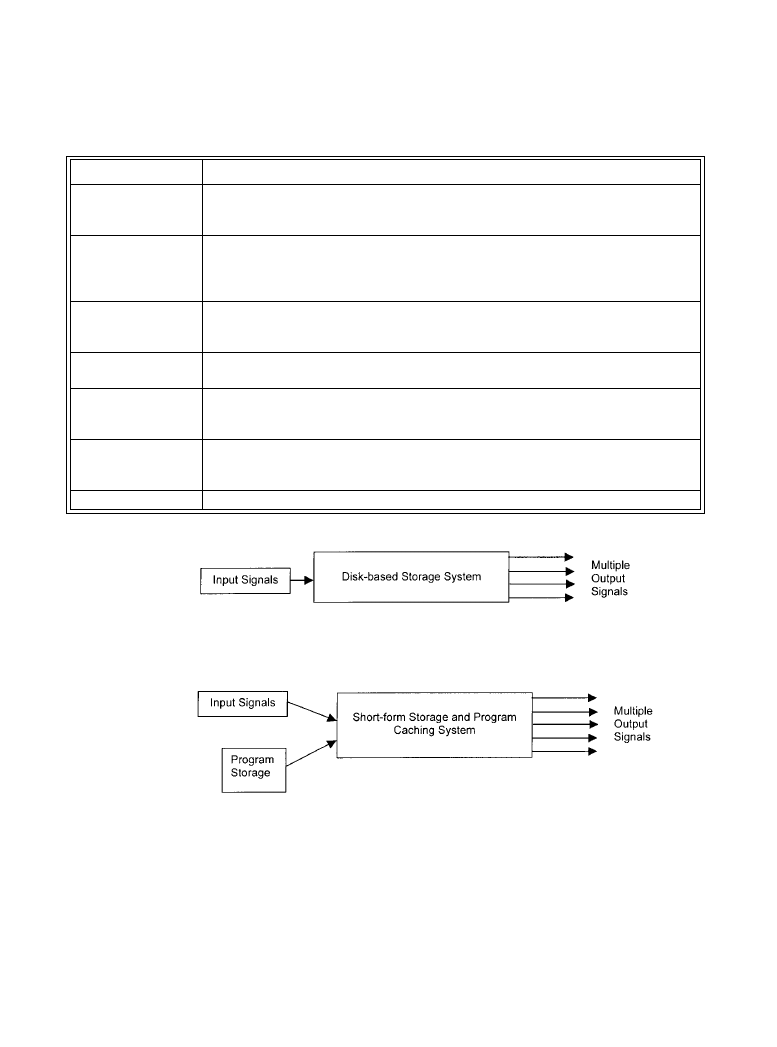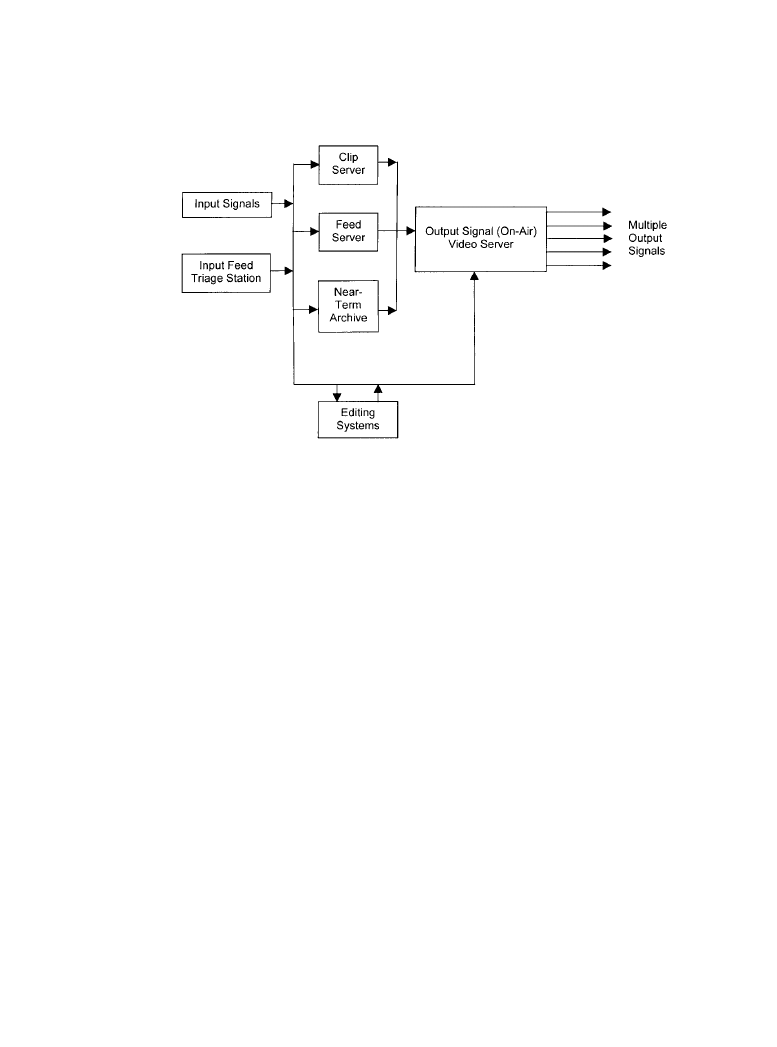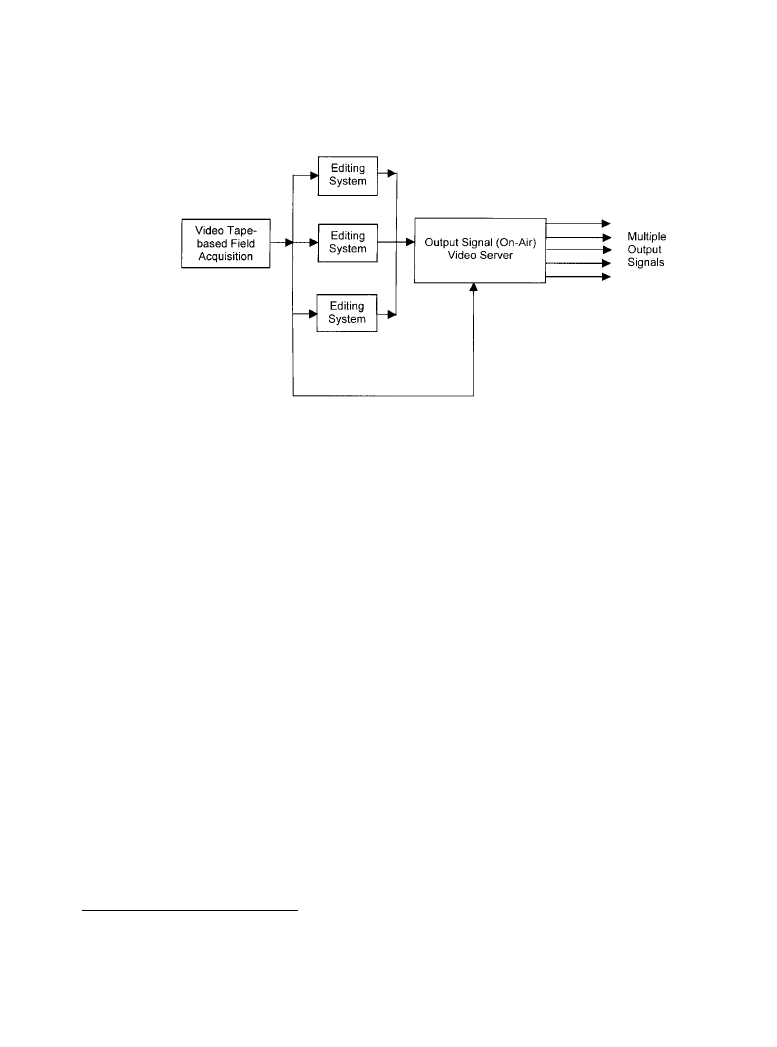ВУЗ: Казахская Национальная Академия Искусств им. Т. Жургенова
Категория: Книга
Дисциплина: Не указана
Добавлен: 03.02.2019
Просмотров: 21727
Скачиваний: 19

Audio/Video Server Systems 9-7
•
Production. Wide bandwidth must be provided to meet simultaneous transfer demands for
large uncompressed files with real-time and random access capabilities. In a production facil-
ity, a server stores all compressed or uncompressed audio and video data files for use in post-
production and distribution. The server is central to the production operation and, thus, deter-
mines the overall performance of the facility. Table 9.1.2 lists production server bandwidth
requirements for 4:2:2 video signals.
•
Video on demand (VOD). This server application must deliver a large number of channels,
each of relatively low video quality, such as MPEG-1 (1.5 Mbits/s). A high overall bandwidth
may be required to satisfy all demands. Short access times are necessary for VOD, whereas
long access times permit near-VOD (NVOD) only.
Audio/video servers have redefined many of the common applications of video tape record-
ers. The VTR is being displaced in direct-to-air uses, complex post production, and desktop edit-
ing. As new VTR formats evolve, they will increasingly be aimed at acquisition and long-form
storage applications. Table 9.1.3 lists the digital tape formats in common usage.
Among the technical frontiers for servers is the ability to transfer files at faster than realtime.
Such features place considerable demands on the bandwidth and throughput of the system; how-
ever, they provide many operational benefits, such as accelerated non-linear editing and reduced
program load-up times.
9.1.2a
Server Design
A number of operational scenarios can be implemented with an audio/video server system. The
simplest involves multiple streams of one or two video inputs, as illustrated in Figure 9.1.1. All
the material is stored within the server and plays out to multiple channels as required.
In Figure 9.1.2, the basic system is expanded to allow for some material, particularly long
form programs, to be held in an external storage area or device (most likely on tape) and loaded
into the server on an as-needed basis to coexist with the short-form (typically commercial)
library that is stored in the server. The server then manages the entire play-out process to one or
more outputs.
Table 9.1.2 Production and Broadcast Server Bandwidth Requirements for 4:2:2 Video Sig-
nals
(
After [1].)
Production Applications
Bandwidth, Mbits/s
Sample Resolution
Compression Ratio
High-end post-production
270
10
1
Typical post-production
90
10
2.3:1
Low-end post-production
25–50
8
6.6:1–3.3:1
News (compressed data)
18–25
8
9:1–6.6:1
HDTV broadcast
20
8
10:1–50:1
Good-quality SDTV broadcast
8
8
20:1
Medium-quality SDTV broadcast
3
8
55:1
Low-quality SDTV broadcast
1.5
8
110:1
Audio/Video Server Systems
Downloaded from Digital Engineering Library @ McGraw-Hill (www.digitalengineeringlibrary.com)
Copyright © 2004 The McGraw-Hill Companies. All rights reserved.
Any use is subject to the Terms of Use as given at the website.

9-8 Audio Recording Systems
In Figure 9.1.3, a large-scale system is depicted typical of a newsroom environment. Feeds
are brought into the system through a triage station permitting rough editing of material (“keep
or discard” decisions). The selected material is then stored in a feed server, which is accessible
Table 9.1.3 Digital Video Tape Formats
Format Designation
Format Description
D1
A format for digital video tape recording conforming to the ITU-R Rec. 601 (4:2:2) standard
using 8-bit sampling. The tape is 19 mm wide and allows up to 94 minutes to be recorded on
a cassette.
D2
The VTR standard for digital composite (encoded) NTSC or PAL signals. D2 uses 19 mm
tape and records up to 208 minutes on a single cassette. Neither cassettes nor recording for-
mats are compatible with D1. D2 has often been used as a direct replacement for 1-inch ana-
log (Type
C
) VTRs.
D3
A VTR standard using 1/2-inch tape cassettes for recording digitized composite (encoded)
NTSC or PAL signals sampled at 8 bits. Cassettes are available ranging from 50–245 min-
utes.
D4
There is no D4 designation; most DVTR formats were developed in Japan where “4” is
regarded as an unlucky number.
D5
A VTR formal using the same cassette as D3 but recording component signals sampled to
ITU-R Rec. 601 at 10-bit resolution. With internal decoding, D5 VTRs can play back D3 tapes
and provide component video outputs.
D6
A helical-scan digital tape format that uses a I9 mm cassette to record uncompressed HDTV
material at 1.88 Gbits/s. D6 accepts both the European 1250/50 interlaced format and the
SMPTE 260M version of the 1125/60 interlaced format, which uses 1035 active lines.
D7
The designation assigned to the DVCRPO recording format.
Figure 9.1.1
Simple application of a video server in a one-in, many-out configuration.
Figure 9.1.2
A server system expanded to utilize long-form program storage.
Audio/Video Server Systems
Downloaded from Digital Engineering Library @ McGraw-Hill (www.digitalengineeringlibrary.com)
Copyright © 2004 The McGraw-Hill Companies. All rights reserved.
Any use is subject to the Terms of Use as given at the website.

Audio/Video Server Systems 9-9
for viewing or by editors for story composition. Completed program elements are forwarded to
the on-air server, which stores them and plays-out as needed. Also shown in the Figure is a clip
server, a low-resolution companion server that delivers video to multiple desktop viewing and
editing systems.
Audio/video servers are often constructed from off-the-shelf computer components by inte-
grating the basic hardware and software. This approach promotes a migration path for future
growth in several ways, including:
•
Utilization of standardized components
•
Enhanced ability to expand or alter the system
•
Ability to upgrade system core capabilities with new software releases
By utilizing standard components, the research and development cost are spread across a
large market, providing faster and more cost-effective advancement. For example, all disk drives
adhere to a similar footprint, respond to a similar set of commands, mount in a similar manner,
and so forth. This makes it easy to take advantage of improvements in specific technologies.
9.1.2b
Archiving Considerations
As a conventional tape library grows, a two-sided challenge unfolds. First, operators must iden-
tify and archive the contents of the tape. Next, they must be able to find the tape. Servers inher-
ently must maintain a database of the materials within their contents and manage the recall of
Figure 9.1.3
A server system designed for editing-intensive applications involving a variety of pro-
gram inputs and distribution requirements.
Audio/Video Server Systems
Downloaded from Digital Engineering Library @ McGraw-Hill (www.digitalengineeringlibrary.com)
Copyright © 2004 The McGraw-Hill Companies. All rights reserved.
Any use is subject to the Terms of Use as given at the website.

9-10 Audio Recording Systems
that material on demand. In addition, because the server brings basic data storage concepts into
play, more use is can be made of asset management software that permits identification and loca-
tion of all materials and their contents, regardless of the storage medium.
Tape, however, remains an exceptionally robust and inexpensive medium for field acquisition.
It also is economical for many long-form materials and for archiving. Tape and servers can work
together to provide a performance and economic model that offers maximum benefit to the user.
As illustrated in Figure 9.1.4, raw footage is acquired on tape. The tape material is loaded into
the editors for composition, and the finished programs are forwarded to a server, where it is held
for play-out.
Despite the many benefits of server systems, there are a few drawbacks. Catastrophic failure
is first among them. Tape, as a medium, is not susceptible to catastrophic failure (generally
speaking). Disk drives can—and do—crash. However, advancements in drive technology have
greatly increased the mean time between failure for disk drives. RAID (redundant array of inde-
pendent disks)
1
schemes provides built-in back-up, particularly when linked with hot spare
drives and hot-swappable components such as power supplies. With these additions, the risk of
total failure of a server system is quite low.
9.1.2c
Audio/Video Server Storage Systems
Because of the fundamental impact that storage technology has on any server, it is important to
understand the various RAID configurations commonly in use. The typical solution to providing
access to many gigabytes of data to users fast and reliably has been to assemble a number of
drives together in a “gang” or array of disks. Simple RAID subsystems are basically a group of
1. Also known as redundant array of inexpensive disks
Figure 9.1.4
A video tape-to-server environment with editing capabilities.
Audio/Video Server Systems
Downloaded from Digital Engineering Library @ McGraw-Hill (www.digitalengineeringlibrary.com)
Copyright © 2004 The McGraw-Hill Companies. All rights reserved.
Any use is subject to the Terms of Use as given at the website.

Audio/Video Server Systems 9-11
up to five or six disk drives assembled in a cabinet that are all connected to a single controller
board. The RAID controller orchestrates read and write activities in the same way a controller for
a single disk drive does, and treats the array as if it were—in fact—a single or “virtual” drive.
RAID management software, which resides in the host system, provides the means to control the
data being stored on the RAID subsystem.
Despite its multi-drive configuration, the individual disk drives of a RAID subsystem remain
hidden from the user; the subsystem itself is the virtual drive, though it can be as large as 1,000
GB or more. The phantom virtual drive is created at a lower level within the host operating sys-
tem through the RAID management software. Not only does the software set up the system to
address the RAID unit as if it were a single drive, it allows the subsystem to be configured in
ways that best suit the general needs of the host system.
RAID subsystems can be optimized for performance, highest capacity, fault tolerance, or a
combination of these attributes. Different RAID levels have been defined and standardized in
accordance with these general optimization parameters. There are six common standardized
RAID levels, called RAID 0, 1, 2, 3, 4, and 5. The use of a particular level depends upon the per-
formance, redundancy, and other attributes required by the host system.
The RAID controller board is the hardware element that serves as the backbone for the array
of disks; it not only relays the input/output (I/O) commands to specific drives in the array, but
provides the physical link to each of the independent drives so they may easily be removed or
replaced. The controller also serves to monitor the integrity of each drive in the array to antici-
pate the need to move data should it be placed in jeopardy by a faulty or failing disk drive (a fea-
ture known as fault tolerance).
9.1.3
Basic Drive Technology
SCSI (small computer system interface) hard disk drives are the foundation of most RAID sys-
tems. The drives use various numbers of magnetic coated disks that rotate at 5,400, 7,200, or
10,000 RPM [2]. Each disk has two recording surfaces. The disks are logically divided into con-
centric circles (tracks). A set of tracks at a given position on the disks is known as a cylinder. The
number of cylinders is the same as the number of tracks across the disks. Tracks are then divided
into varying numbers of sectors. The number of sectors varies according to the position of the
track located on the disk. This technology is known as zone bit recording (ZBR).
Data are written to one track of a given surface at a time. If more space is needed, a head
switch takes place and data then are written to the next surface. Head switches continue down the
cylinder until the last track in the cylinder is filled. If additional space is needed, the heads are
stepped to a new cylinder and the process of head switching and track stepping continues until
the file is completed. Using ZBR, the outside tracks contain more sectors than the inside tracks
because there is more physical space on the outside tracks. The transfer rate is greater from the
outside as well because a greater amount of data is available from a single rotation of the disks.
The first partition created uses the outside tracks and moves to inside tracks as the drive or drives
are fully partitioned.
SCSI is a general-purpose interface. In its basic configuration, a maximum of eight or 16
devices can be connected to a single bus. SCSI specifies a cabling standard, a protocol for send-
ing and receiving commands, and the format for those commands. SCSI is intended as a device-
Audio/Video Server Systems
Downloaded from Digital Engineering Library @ McGraw-Hill (www.digitalengineeringlibrary.com)
Copyright © 2004 The McGraw-Hill Companies. All rights reserved.
Any use is subject to the Terms of Use as given at the website.